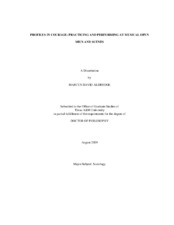| dc.description.abstract | This dissertation explores the social patterns and cultural layers of musical "open mics"
in New York City. The study uses a qualitative approach which includes methods such as
ethnography, in-depth interviewing, historical and discourse analyses focusing on open mics and
the popular musicians who attend and perform them. Open mics, short for "open microphones,"
are public events that allow musicians to perform songs without a pre-planned, formal booking
with a club or venue. Owing a historical and discursive connection to the folk hootenannies and
jazz jam sessions of the past, these events have proliferated and spread considerably across the
United States since the 1990s since their development, by name, in the late 1970s. Open mics not
only reflect a do-it-yourself and participatory cultural ethos manifested with other recent
expressive cultural activities, but also demonstrate a growing interstitial "musical third place"
residing between private practicing and public performance.
Musical open mics as musical third places provide musicians and singer/songwriters to
network with other musicians, practice new musical compositions and play when other
performance opportunities are not readily available. It provides a means for musicians to "hone
their craft" in terms of performance methods and also construct musical identities in the almost
exclusive company of other working singer/songwriters. This "backstage region" is thus framed
and keyed by the musicians onto a continuum between two theoretical poles: performance practicing and practicing performance. Performance practicing as defined in this study frames a
more performance-oriented display for musicians in locations called "closed open mics" or
COMs. These settings, also residing on a theoretical continuum are socially more exclusive in
terms of performance types, the aesthetic careers of the performers, the genres represented and
the sociological makeup of the setting participants in general. OOMs or "open open mics," on
the other hand, usually have a more fluid, diverse sociological composition of musical
performers, performance types, and musical genres played and represented in these mainly
weekly events. Closed open mics align into more homogeneous, isomorphic settings comprising
"local open mic scenes" and open open mics remain more heterogeneous, socially inclusive, and
unsettled as "pre-scenes." | en |


